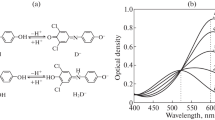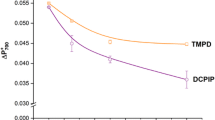Summary
Starting with the frequently used dye 2,6-dichloroindophenol some of the chemical properties of the quinonimide class of dyes are described. Consideration of the effects of completing a hetero-six-membered ring, as in the azine, thiazine and oxazine classes, on the properties of the compounds is suggested as a lead towards the development of some redox indicators perhaps more desirable than the indophenols. This approach developed from a study of the Liebermann nitroso-reaction for phenols. Some properties of the redox indicators which resulted from that work are described in relation to energy transduction in the chloroplast.
Similar content being viewed by others
References
H. G. Gibbs, W. L. Hall and W. Mansfield Clark, Supplement No. 69 to the Public Health reports, Washington DC (1928).
A. S. Holt and C. S. French,Arch. Biochem.,19 (1948) 368.
P. Ehrlich,Das Sauerstoff-Bedürfniss des Organismus, Hirschwald, Berlin, 1885, see also “The Requirement of the Organism for Oxygen” tr. editors, inThe Collected Papers of Paul Ehrlich, Vol. 1, H. H. Dale, F. Himmelweit and M. Marquardt (eds.), Pergamon Press, 1956, p. 433.
International Union of Biochemistry: Report of the Commission on Enzymes (1964). (Reprinted inComparative Biochemistry, Vol. 13, M. Florkin and E. H. Stotz (eds.), 1965, p. 84.
F. Rohmann and W. Spitzer,Chem. Ber.,28 (1895) 567.
D. Keilin,Proc. R. Soc. London B104 (1929) 206.
W. Mansfield Clark,Oxidation-Reduction Potentials of Organic Systems, Baillière, Tindall and Cox, London, 1960.
E. S. G. Barron,J. Biol. Chem. 97 (1932) 287.
R. Hill, G. R. Bedford and B. R. Webster,J. Chem. Soc. G1970, 478.
C. Liebermann,Chem. Ber.,7 (1874) 1098.
A. Baeyer and H. Caro,Chem. Ber.,7 (1874) 963.
R. Nietzki,Chemistry of the Organic Dyestuffs, tr. A. Collin and W. Richardson, Gurney and Jackson, London, 1892, p. 165.
F. Kehrmann, H. Goldstein and P. Tschudi,Helv. Chim. Acta,2 (1919) 2315.
H. Goldstein and W. Kopp,Helv. Chim. Acta,11 (1928) 478.
B. R. Webster and G. R. Bedford, personal communication, 1970.
J. F. Corbett,J. Chem. Soc. B1970, 1418.
N. E. Good, personal communication, 1971.
D. M. Stokes and D. A. Walker, personal communication, 1970.
H. Brunner and P. Chuit,Chem. Ber.,21 (1888) 249.
Beilstein's Handbuch, 4 Aufl.,6 (1923) 137.
Author information
Authors and Affiliations
Rights and permissions
About this article
Cite this article
Hill, R. A note on some old and some possible new redox indicators. J Bioenerg Biomembr 4, 229–237 (1973). https://doi.org/10.1007/BF01516059
Issue Date:
DOI: https://doi.org/10.1007/BF01516059




